Planet View: N39°35.191’ E19°49.175’
Street View: N39°35.191’ E19°49.175’
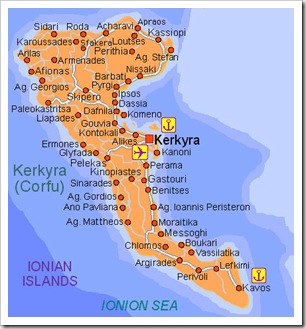
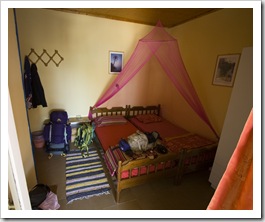 First off, a little explanation of the post’s title: most tourists know the island of Kerkyra by its tourist name, Corfu, which was instantiated because English-speaking tourists had trouble with the traditional Greek name of Kerkyra. So if you’ve heard of Corfu before, it’s actual name is Kerkyra, so that’s what we’ll use here… We traveled to Kerkyra from Santorini to explore one of the Ionian islands off Greece’s west coast. We also wanted to see where my mum spent her summers teaching water-skiing and romping about in a bikini when she was in her twenties, I’ve heard a lot of stories about her time on Kerkyra so we thought a visit was in order. Kerkyra’s landscape is markedly different to that of the volcanic Cyclades islands (Santorini is one of the Cyclades): the black rocks and barren landscapes are replaced by lush greenery and rolling hills on
First off, a little explanation of the post’s title: most tourists know the island of Kerkyra by its tourist name, Corfu, which was instantiated because English-speaking tourists had trouble with the traditional Greek name of Kerkyra. So if you’ve heard of Corfu before, it’s actual name is Kerkyra, so that’s what we’ll use here… We traveled to Kerkyra from Santorini to explore one of the Ionian islands off Greece’s west coast. We also wanted to see where my mum spent her summers teaching water-skiing and romping about in a bikini when she was in her twenties, I’ve heard a lot of stories about her time on Kerkyra so we thought a visit was in order. Kerkyra’s landscape is markedly different to that of the volcanic Cyclades islands (Santorini is one of the Cyclades): the black rocks and barren landscapes are replaced by lush greenery and rolling hills on 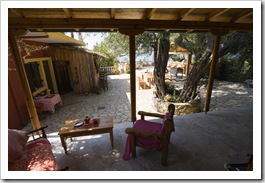 Kerkyra, its limestone base makes for excellent coves and beautiful sandy beaches all around the island. We left Santorini in the midst of horizontal rain and gale-force winds (we were a little concerned that our plane wasn’t going to take off!) to arrive in Kerkyra under clear blue skies and 32°C (90°F) weather. We stayed at the Rolling Stone above Pelekas Beach (N39°35.191’ E19°49.175’) on the island’s
Kerkyra, its limestone base makes for excellent coves and beautiful sandy beaches all around the island. We left Santorini in the midst of horizontal rain and gale-force winds (we were a little concerned that our plane wasn’t going to take off!) to arrive in Kerkyra under clear blue skies and 32°C (90°F) weather. We stayed at the Rolling Stone above Pelekas Beach (N39°35.191’ E19°49.175’) on the island’s 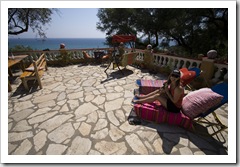
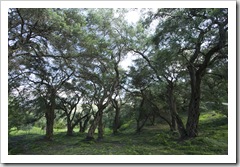 west coast, a small hippie-inspired hotel of six rooms and a couple of apartments run by German-born Ira and her friendly Greek ever-so-stylish husband Themis. Themis picked us up from the airport for a hair-rising ride across the 17 kilometer stretch between Kerkyra Town and Pelekas dressed in his pointed cowboy boots, tight jeans and a stylin’ t-shirt that would make Todd Baldwin jealous. The Rolling Stone was great (if you don’t mind a bit of late night music in the courtyard now and then), we were even invited to eat dinner with Themis and Ira’s family on our first night, a
west coast, a small hippie-inspired hotel of six rooms and a couple of apartments run by German-born Ira and her friendly Greek ever-so-stylish husband Themis. Themis picked us up from the airport for a hair-rising ride across the 17 kilometer stretch between Kerkyra Town and Pelekas dressed in his pointed cowboy boots, tight jeans and a stylin’ t-shirt that would make Todd Baldwin jealous. The Rolling Stone was great (if you don’t mind a bit of late night music in the courtyard now and then), we were even invited to eat dinner with Themis and Ira’s family on our first night, a 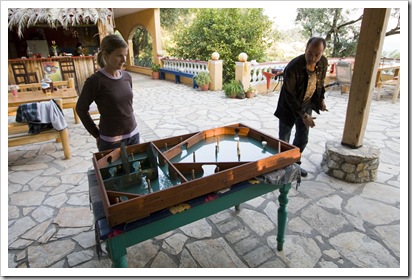 scrumptious Kerkyran specialty of stewed veal and pasta. Lisa fell in love with Rolling Stone’s seven month old pup named Maggie, a couple of times Maggie would be waiting outside our bedroom door in the morning as she quickly learned we were always good for attention. Kerkyra is only about 150 kilometers from the eastern coast of Italy, it’s quite a big island, during our four and a
scrumptious Kerkyran specialty of stewed veal and pasta. Lisa fell in love with Rolling Stone’s seven month old pup named Maggie, a couple of times Maggie would be waiting outside our bedroom door in the morning as she quickly learned we were always good for attention. Kerkyra is only about 150 kilometers from the eastern coast of Italy, it’s quite a big island, during our four and a 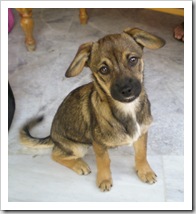 half days there we only managed to explore the top half of its 58 kilometer span. The island is absolutely covered with olive trees, 99.9% of the harvest is devoted to making olive oil due to the small size of the fruit produced by the particular species of trees on the island. The olive groves on Kerkyra are the tallest olive trees either of us has ever seen, they tower 30 or 40 feet tall with trunks that resemble the oaks in California. The harvest is performed by laying black synthetic netting over the ground throughout the entire grove and then catching the fruit as it falls (we couldn’t quite gather if they shake the trees or wait for the olives to drop naturally). The groves were really a sight to behold, everyone we met who was a local seemed to have a grove somewhere on the island.
half days there we only managed to explore the top half of its 58 kilometer span. The island is absolutely covered with olive trees, 99.9% of the harvest is devoted to making olive oil due to the small size of the fruit produced by the particular species of trees on the island. The olive groves on Kerkyra are the tallest olive trees either of us has ever seen, they tower 30 or 40 feet tall with trunks that resemble the oaks in California. The harvest is performed by laying black synthetic netting over the ground throughout the entire grove and then catching the fruit as it falls (we couldn’t quite gather if they shake the trees or wait for the olives to drop naturally). The groves were really a sight to behold, everyone we met who was a local seemed to have a grove somewhere on the island.
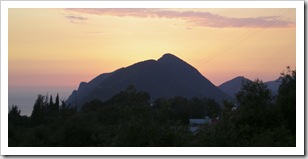
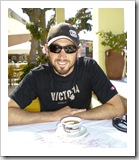
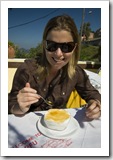
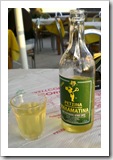 The island’s west coast was the most picturesque area we explored: beautiful rolling green hills dotted with white-walled, red-roofed villages and limestone cliffs that make for fantastic coves and beautiful beaches. Pelekas, where we stayed, is in the center of the west coast and is one of the best beaches we found during our time on Kerkyra. The beach was about 100 meters down the hill
The island’s west coast was the most picturesque area we explored: beautiful rolling green hills dotted with white-walled, red-roofed villages and limestone cliffs that make for fantastic coves and beautiful beaches. Pelekas, where we stayed, is in the center of the west coast and is one of the best beaches we found during our time on Kerkyra. The beach was about 100 meters down the hill 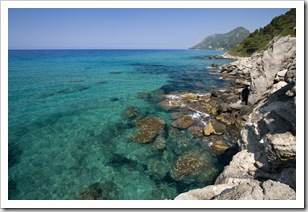
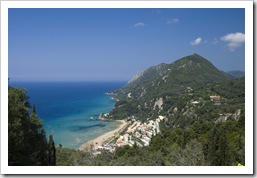 from the Rolling Stone, white sand stretching for a kilometer or so hemmed in by limestone ridges at either end (typical of all the beaches on Kerkyra). The water was warmer than Santorini but still a little chilly, the clarity and turquoise color was second to none though. The town of Pelekas was a (very) steep walk up the winding road from the beach, about 45 minutes each way. We ate in Pelekas twice at Alexandro’s Pizza, probably the best pizza either one of us has ever tasted, the second time we dined we ordered a whole pizza each and prepped by fasting from breakfast to make room! We also made the drive up to Paleokastritsa (pictured to the left below) (N39°40.369’ E19°42.062’), one of Kerkyra’s most famed coastal areas, to take a look at the amazing array of coves and beaches dotted along the nearby coast. These days the area is littered with beachfront restaurants and bars as well
from the Rolling Stone, white sand stretching for a kilometer or so hemmed in by limestone ridges at either end (typical of all the beaches on Kerkyra). The water was warmer than Santorini but still a little chilly, the clarity and turquoise color was second to none though. The town of Pelekas was a (very) steep walk up the winding road from the beach, about 45 minutes each way. We ate in Pelekas twice at Alexandro’s Pizza, probably the best pizza either one of us has ever tasted, the second time we dined we ordered a whole pizza each and prepped by fasting from breakfast to make room! We also made the drive up to Paleokastritsa (pictured to the left below) (N39°40.369’ E19°42.062’), one of Kerkyra’s most famed coastal areas, to take a look at the amazing array of coves and beaches dotted along the nearby coast. These days the area is littered with beachfront restaurants and bars as well 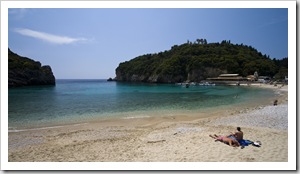
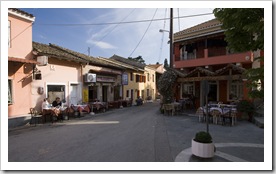 as a myriad of hotels catering to the western European package tourists that flock there during the peak of summer. The natural beauty of the place is still in tact though, we made a short walk north of the main strip to find a small cove to ourselves where we spent the afternoon on the beach and snorkeling in the crystal clear Ionian Sea. While on our way home from Paleokastritsa we took a bit of detour and found a gem hidden away in the west coast’s hills, the town of Doukades (pictured here to the left) is a sleepy mountain village with a couple of small tavernas spread around the center of town. We enjoyed a great dinner, scrumptious home-made dolmades
as a myriad of hotels catering to the western European package tourists that flock there during the peak of summer. The natural beauty of the place is still in tact though, we made a short walk north of the main strip to find a small cove to ourselves where we spent the afternoon on the beach and snorkeling in the crystal clear Ionian Sea. While on our way home from Paleokastritsa we took a bit of detour and found a gem hidden away in the west coast’s hills, the town of Doukades (pictured here to the left) is a sleepy mountain village with a couple of small tavernas spread around the center of town. We enjoyed a great dinner, scrumptious home-made dolmades 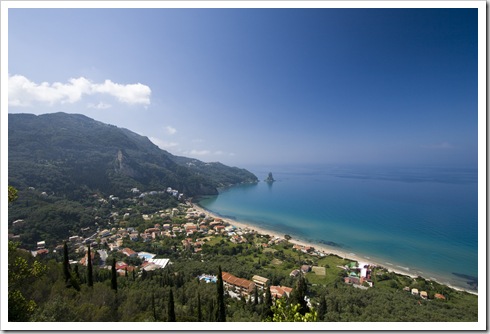 and our first time sampling oven-baked feta. On our second to last day we made a
and our first time sampling oven-baked feta. On our second to last day we made a 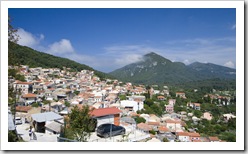 trip south down the west coast from Pelekas, we passed another famous bathing spot on the way, Agios Gordis, recognizable by the small rock island of Tholeto at the southern end of the beach (pictured here to the left). We were searching for more beaches and coves along the coast but didn’t find anything as spectacular as
trip south down the west coast from Pelekas, we passed another famous bathing spot on the way, Agios Gordis, recognizable by the small rock island of Tholeto at the southern end of the beach (pictured here to the left). We were searching for more beaches and coves along the coast but didn’t find anything as spectacular as 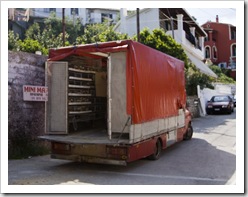 Paleokastritsa or any stretches of sand as nice as Glyfada or Pelekas (where we were staying). Fun to make the drive though, and the quaint mountain village of Agios Mattheos was interesting to drive through. A bit of an eye-opener we encountered a number of times on Kerkyra, something we didn’t see anywhere else in Greece or Turkey, were mobile chicken markets: small trucks with their cargo sections turned into chicken hatcheries! They’d drive around the island with loudspeakers attached to the roof hooting and hollering about their chickens for sale. We had to pull over to let the one pictured here pass us on one of the skinny streets of Agios Mattheos.
Paleokastritsa or any stretches of sand as nice as Glyfada or Pelekas (where we were staying). Fun to make the drive though, and the quaint mountain village of Agios Mattheos was interesting to drive through. A bit of an eye-opener we encountered a number of times on Kerkyra, something we didn’t see anywhere else in Greece or Turkey, were mobile chicken markets: small trucks with their cargo sections turned into chicken hatcheries! They’d drive around the island with loudspeakers attached to the roof hooting and hollering about their chickens for sale. We had to pull over to let the one pictured here pass us on one of the skinny streets of Agios Mattheos.
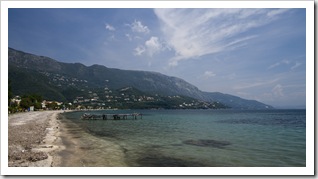
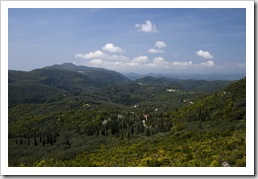 We made the trek to the island’s north coast a couple of times during our stay on Kerkyra: once to visit Sidari and Roda Beach, the other to hike part of the Corfu Trail from Strinilas to Moni Pantokratora (Kerkyra’s tallest peak). Our trip to Sidari and Roda was a little disappointing, the once beautiful beaches and picturesque seaside towns have been turned into masses of English pubs and gaudy souvenir shops, there wasn’t much Greek to see at either spot. Mum had told me stories of her painting the Roda Beach Hotel in her bikini, at that time the first hotel in Roda, as well as spending time sunbathing on the beautiful beaches around Sidari.
We made the trek to the island’s north coast a couple of times during our stay on Kerkyra: once to visit Sidari and Roda Beach, the other to hike part of the Corfu Trail from Strinilas to Moni Pantokratora (Kerkyra’s tallest peak). Our trip to Sidari and Roda was a little disappointing, the once beautiful beaches and picturesque seaside towns have been turned into masses of English pubs and gaudy souvenir shops, there wasn’t much Greek to see at either spot. Mum had told me stories of her painting the Roda Beach Hotel in her bikini, at that time the first hotel in Roda, as well as spending time sunbathing on the beautiful beaches around Sidari. 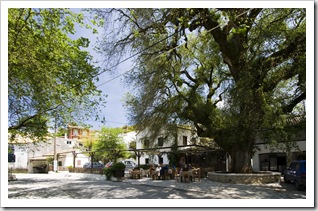 But now, just like Bodrum, both locales have been overrun with package tourists from western Europe and the towns’ charm has mostly disappeared. We didn’t even take any photos, and on this trip that’s a stretch! Not to be deterred, we talked to some locals about the Corfu Trail, a hiking trail covering some 227 kilometers around the island, and ventured back to the island’s north on another day to walk a section of it up to the peak of Moni Pantokratora (N39°44.027’ E19°50.853’). The road to Strinilas (N39°44.656’ E19°50.226’), the starting point of our hike, follows the east coast of Kerkyra until Pirgi, at which point it veers off the main drag and winds up into the mountains. The road after Pirgi has bends that, in the words of one guide book,
But now, just like Bodrum, both locales have been overrun with package tourists from western Europe and the towns’ charm has mostly disappeared. We didn’t even take any photos, and on this trip that’s a stretch! Not to be deterred, we talked to some locals about the Corfu Trail, a hiking trail covering some 227 kilometers around the island, and ventured back to the island’s north on another day to walk a section of it up to the peak of Moni Pantokratora (N39°44.027’ E19°50.853’). The road to Strinilas (N39°44.656’ E19°50.226’), the starting point of our hike, follows the east coast of Kerkyra until Pirgi, at which point it veers off the main drag and winds up into the mountains. The road after Pirgi has bends that, in the words of one guide book, 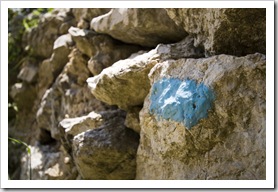 make the Monaco Grand Prix look like a walk in the park! We do agree, it’s probably one of the windiest roads either of us has ever been on, Lisa had that pale ‘I’m going to be sick’ look plastered across her face a number of times. But the drive was worth it, as we reached the highlands we were greeted with
make the Monaco Grand Prix look like a walk in the park! We do agree, it’s probably one of the windiest roads either of us has ever been on, Lisa had that pale ‘I’m going to be sick’ look plastered across her face a number of times. But the drive was worth it, as we reached the highlands we were greeted with 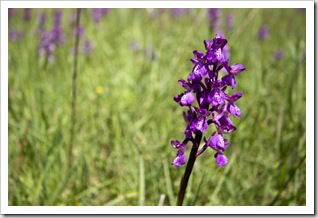 fields of beautiful wildflowers and views across the entire northern end of the island. We found a taverna on Strinilas’ central square and talked to the waiter about the Corfu Trail; turned out that the trail passed through the taverna’s courtyard so after lunch we made the roughly 12 kilometer loop to the peak of Moni Pantokratora through some beautiful farmland and very picturesque fields of highland wildflowers. At times we were following the blue markers, others we had to use the surrounding hills as a guide and wing it to the next blue marker, at which point one of us would yell “blue paint” with some relief. Similar to our trip on a portion of the Lycian Way in Turkey the blue markers of the Corfu Trail were lifesavers. We walked back along the road to the east of our route up and were rewarded with some fantastic views of the island’s east coast. For our drive back that day we took the long way around the northern and eastern edges of the island, taking in the beautiful beach at Almiros, the town of Kassiopi and finally stopping for a beer at a waterfront taverna in Nissaki.
fields of beautiful wildflowers and views across the entire northern end of the island. We found a taverna on Strinilas’ central square and talked to the waiter about the Corfu Trail; turned out that the trail passed through the taverna’s courtyard so after lunch we made the roughly 12 kilometer loop to the peak of Moni Pantokratora through some beautiful farmland and very picturesque fields of highland wildflowers. At times we were following the blue markers, others we had to use the surrounding hills as a guide and wing it to the next blue marker, at which point one of us would yell “blue paint” with some relief. Similar to our trip on a portion of the Lycian Way in Turkey the blue markers of the Corfu Trail were lifesavers. We walked back along the road to the east of our route up and were rewarded with some fantastic views of the island’s east coast. For our drive back that day we took the long way around the northern and eastern edges of the island, taking in the beautiful beach at Almiros, the town of Kassiopi and finally stopping for a beer at a waterfront taverna in Nissaki.
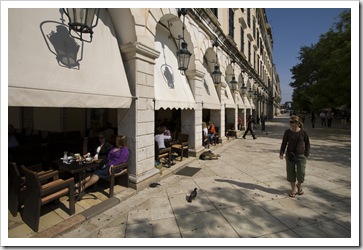
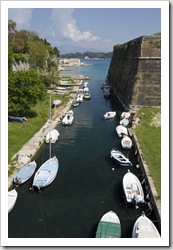 Kerkyra Town (Corfu Town), the main village on the island, was a real highlight for us. The bustling central location of the island is in the middle of the east coast just next to the airport and is where most of the Greek inhabitants of Kerkyra reside. Unlike Santorini, which effectively becomes a ghost town during the winter months, the majority of the Greek population live on Kerkyra year round. Kerkyra Town is about 17 kilometers from where we stayed on Pelekas, a quick drive across the island in our little rental car. The roads were extremely confusing, I don’t think we took the same route twice during our five days on the island, once ending up having a heated finger-pointing match as we tried to figure out how we found ourselves on the east coast heading up to the mountains when we were supposed to be heading back to Pelekas! Kerkyra Town is a mix of old and new: Palaio Frourio (the old Venetian fortress) and Italian-inspired architecture of the old town intermingled with up-market cafes and modern
Kerkyra Town (Corfu Town), the main village on the island, was a real highlight for us. The bustling central location of the island is in the middle of the east coast just next to the airport and is where most of the Greek inhabitants of Kerkyra reside. Unlike Santorini, which effectively becomes a ghost town during the winter months, the majority of the Greek population live on Kerkyra year round. Kerkyra Town is about 17 kilometers from where we stayed on Pelekas, a quick drive across the island in our little rental car. The roads were extremely confusing, I don’t think we took the same route twice during our five days on the island, once ending up having a heated finger-pointing match as we tried to figure out how we found ourselves on the east coast heading up to the mountains when we were supposed to be heading back to Pelekas! Kerkyra Town is a mix of old and new: Palaio Frourio (the old Venetian fortress) and Italian-inspired architecture of the old town intermingled with up-market cafes and modern 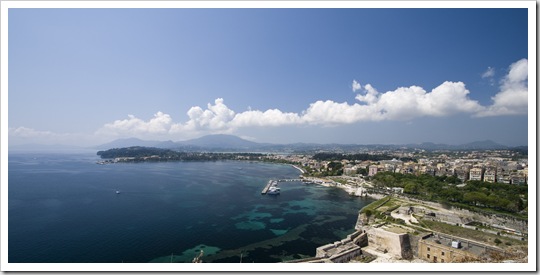 apartment buildings to the town’s west. We read about the plethora of cafes lining the Liston and quickly found that it’s quite an institution
apartment buildings to the town’s west. We read about the plethora of cafes lining the Liston and quickly found that it’s quite an institution 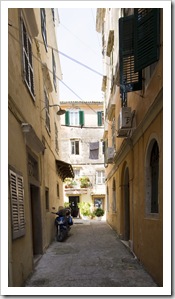 amongst the Kerkyrans to enjoy a coffee for an hour or two at one of the strip’s establishments. We did so ourselves on two mornings, enjoying our Greek coffees which, in Kerkyra at least, are usually served with a croissant or biscotti. The cafes are so popular in Kerkyra’s old town that we actually had trouble (a lot of trouble) finding any form of restaurant or eatery that served food during the morning! The Liston was a fantastic people watching spot, all of the cafes serve alcohol in the evenings and we sat there for quite some time late one night just watching the people go by and adrenaline-fueled kids racing their bicycles through the crowds. The narrow walkways between the Spianada and more modern quarter of Kerkyra Town were great for a walk, we could have been somewhere in Italy instead of an island off Greece. Kerkyra was another great stop along our way, thanks Mum for the idea and also Vassilis for some local knowledge.
amongst the Kerkyrans to enjoy a coffee for an hour or two at one of the strip’s establishments. We did so ourselves on two mornings, enjoying our Greek coffees which, in Kerkyra at least, are usually served with a croissant or biscotti. The cafes are so popular in Kerkyra’s old town that we actually had trouble (a lot of trouble) finding any form of restaurant or eatery that served food during the morning! The Liston was a fantastic people watching spot, all of the cafes serve alcohol in the evenings and we sat there for quite some time late one night just watching the people go by and adrenaline-fueled kids racing their bicycles through the crowds. The narrow walkways between the Spianada and more modern quarter of Kerkyra Town were great for a walk, we could have been somewhere in Italy instead of an island off Greece. Kerkyra was another great stop along our way, thanks Mum for the idea and also Vassilis for some local knowledge.
This entry was posted on Saturday, May 9th, 2009 at 9:30 AM and is filed under Greece. You can follow any responses to this entry through the RSS 2.0 feed. Both comments and pings are currently closed.
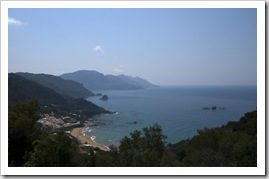
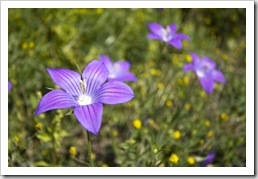
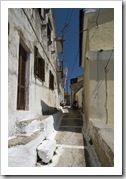
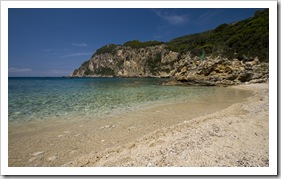
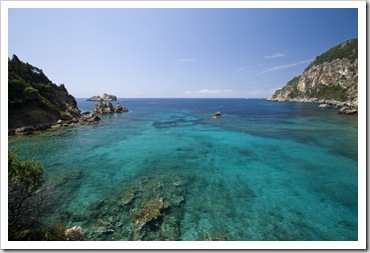
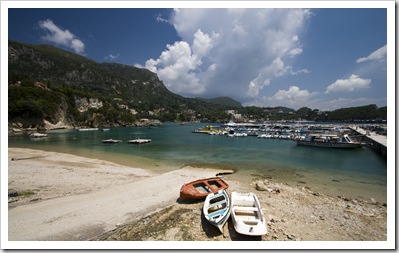
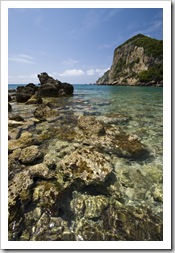
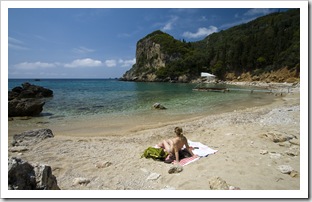
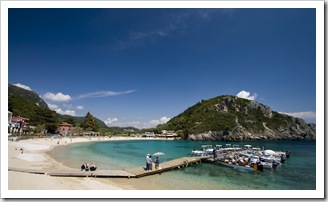
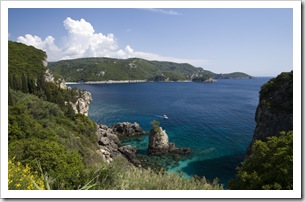
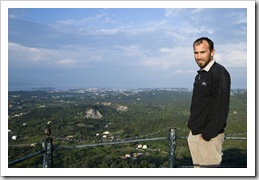
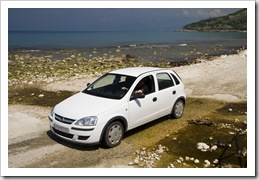
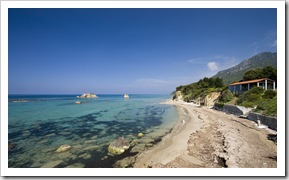
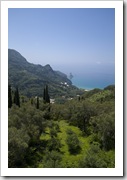
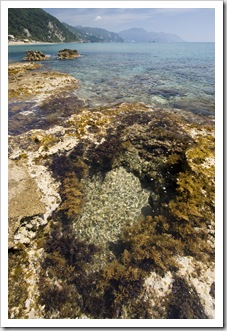
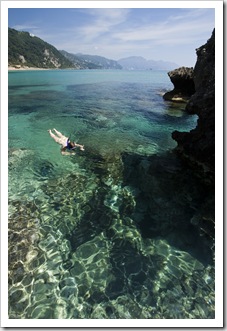
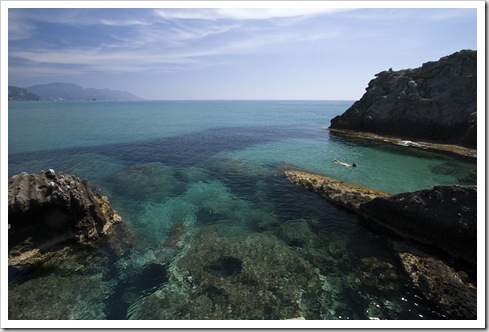
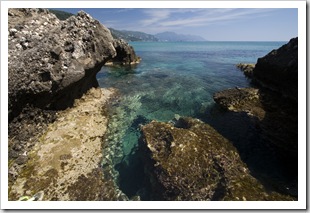
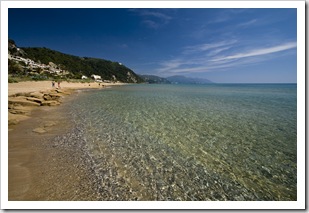
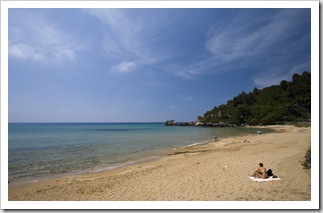
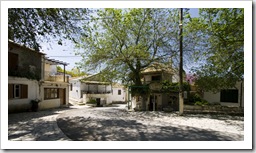
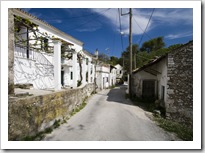
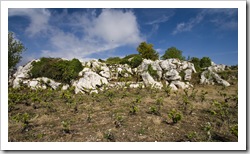
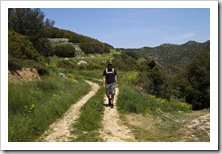
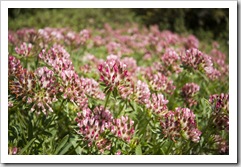
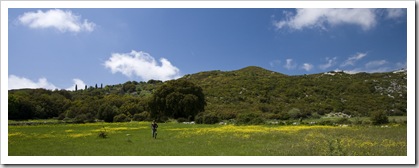
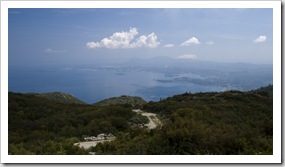
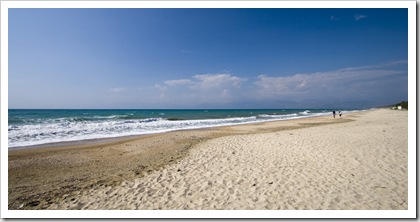
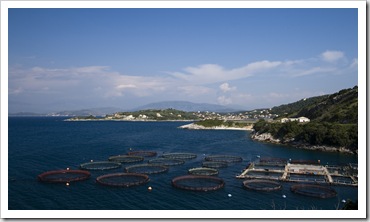
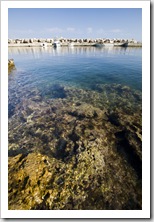

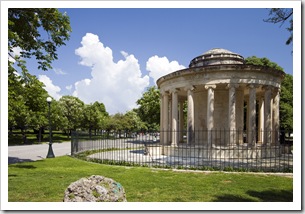
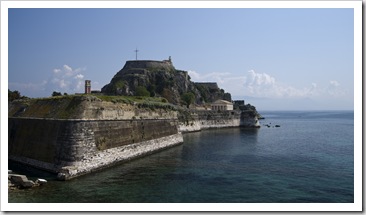
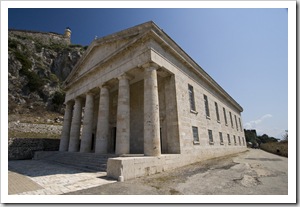
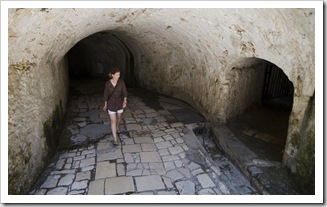
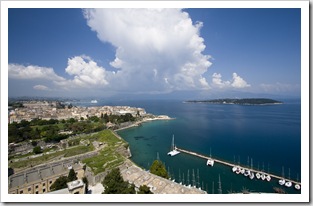
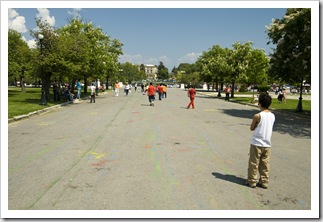
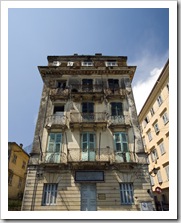
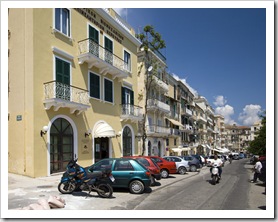
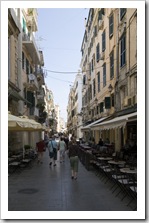
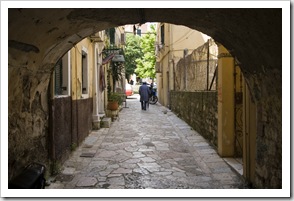
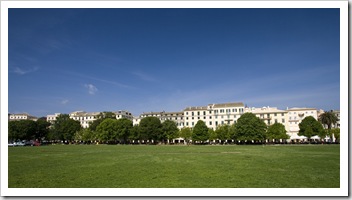
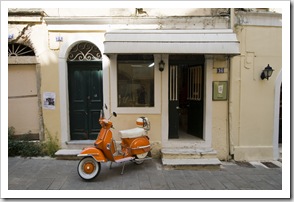

Hi Lisa and Sam
Thanks for the photo of the yoghurt and honey, looks good!
Sally
May 21st, 2009 at 1:09 AM
The yoghurt pic makes my mouth water… YUMMY!!!
May 22nd, 2009 at 11:35 PM
Love the Greece posts! All the photos look like they could be postcards.
Brian especially loved them. When he went on his tour of Greece their camera was stolen, so he holds a special place for his lost photos.
Petaluma misses you, we miss you guys.
Cheers,
Juana (and Brian)
June 2nd, 2009 at 3:54 AM
That could be me except the Vespa will be red.
June 3rd, 2009 at 10:48 AM
hello there… i just dropped over your website while looking for additional info on the little rock island of tholeto at corfu. i shot some pictures myself during my stay… but after seing your masterpieces i feel kind of ashamed to post them heheh. fantastic work, i definitly will bookmark it and read your other posts as well. traveling is pure joy and everyone should do it. open eyes, open heart and open mind… the world is to beautyfull to be missed out.
greatings from zurich.
have fun on all your tripps.
alekos
July 24th, 2010 at 8:16 PM